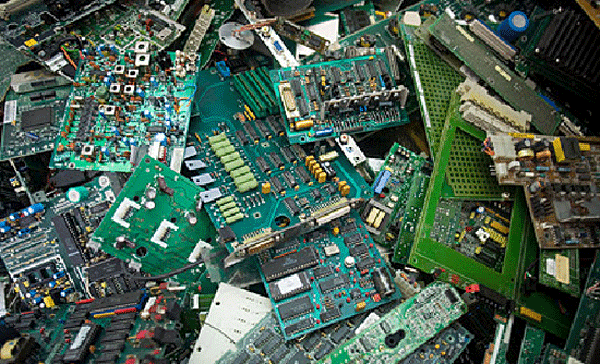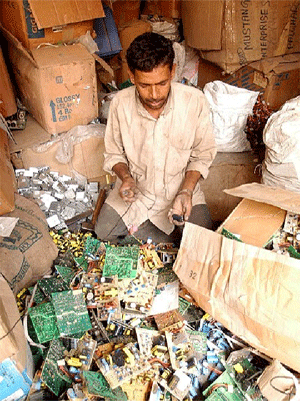Dec 27, 2025
Dec 27, 2025
Modern technology is developing at a rapid pace churning out a range of cool gizmos each year loaded with impressive features to appeal to consumers. The trend generates a temptation to upgrade mobile phones, television, computers and other electronic gadgets more frequently. But there is also a darker side to the technological revolution as Electronic waste becomes the fastest growing component of the municipal solid waste stream.

Electronic waste or more commonly known as ‘E-waste’ refers to discarded electrical or electronic equipments. It is a simplified definition of a complex problem. If dealt with properly, it is seen as an effective resource for secondary raw materials. However, the problem arises when improper disposal of certain elements such as lead, copper, and carbon mixed with smaller amount of cadmium, mercury and other substances which are not bio-degradable become toxic. Once lurking in the shadows of oblivion, E-waste is no longer just an environmental term confined to textbooks, but a new age contamination of serious concern. As Ramapati Kumar of Greenpeace points out: “Electronic waste (e-waste) now makes up five percent of all municipal solid waste worldwide, nearly the same amount as all plastic packaging, but more hazardous while the amount of electronic products discarded globally has skyrocketed recently, with 20-50 million tones generated every year.”
E-waste was initially restricted to developed countries, where the waste was simply dumped in landfills or burnt in incinerators. Added the pressure of coping with the rapid increase in waste generation has led developed countries to look towards Asia as an effective dumping ground for e-waste. The rather one-dimensional solution to eradicate the mounting toxic waste seemed workable at first but with time landfills leaked into the soil and in the case of incineration released into the atmosphere, impacting the nearby communities and the environment. However, the use of landfills to deal with e-waste remains popular in many nations even though some countries under the European Union banned its use by the early 1990s.
In Europe e-waste is increasing at 3 to 5 percent a year, almost three times faster than the total waste stream. At the same time developing countries are expected to triple their own e-waste production over the next five years with Asia already discarding an estimated 12 million tonnes each year. The desperate need for a solution to deal with e-waste effectively and efficiently is undeniable to prevent countries especially Asia from being reduced to one big toxic pit.
 India is the perfect example that mirrors the e-waste predicament faced in Asia, where the basic environmental, health and safety concerns are elevated by unsystematic Transboundary Movements of Hazardous e-wastes and their disposal. The poor infrastructure at the scrapping yards prevents any kind of standards from being properly implemented. The workers disposing e-waste reconcile to these awful working conditions and inadequate safety standards, often unaware that toxics emitted from improper disposal of e-waste could cause a range of severe health issues including respiratory illness and reproductive problems. According to Silicon Valley Toxics coalition, a grassroots organization (California) engaged in human health problems caused by the rapid growth of the high-tech electronics industry, exposure to lead for example, can cause brain damage, nervous damage and blood disorders to name a few while extreme exposure can cause vomiting, diarrhea and even death.
India is the perfect example that mirrors the e-waste predicament faced in Asia, where the basic environmental, health and safety concerns are elevated by unsystematic Transboundary Movements of Hazardous e-wastes and their disposal. The poor infrastructure at the scrapping yards prevents any kind of standards from being properly implemented. The workers disposing e-waste reconcile to these awful working conditions and inadequate safety standards, often unaware that toxics emitted from improper disposal of e-waste could cause a range of severe health issues including respiratory illness and reproductive problems. According to Silicon Valley Toxics coalition, a grassroots organization (California) engaged in human health problems caused by the rapid growth of the high-tech electronics industry, exposure to lead for example, can cause brain damage, nervous damage and blood disorders to name a few while extreme exposure can cause vomiting, diarrhea and even death.
The obvious dangers of improper disposal of E-waste is not invisible but profits generated in recycling and extracting valuable components like copper and gold make it big business. Thus, a huge demand for e-waste which has increased in an alarming rate over the years and should be a reason of concern.
However, there are international laws and initiatives being undertaken to address the issue of e-waste. The Basel Convention adopted by the global community in 1989 is the most notable international law to address hazardous waste. Though India is a signatory to these conventions, it has unfortunately displayed a rather poor record India livelihood is given greater priority to the environment and therefore there remains a reluctance to ratify international treaties. Even if the treaty is ratified, the government fails to follow in letter and spirit. The UN put its support behind the global effort with the creation of ‘Stopping the e-waste Problem’ (StEP) that aims to “initiate and facilitate approaches towards the sustainable handling of e-waste” by bringing together the various actors from governments to NGOs on the same platform. The idea is to find innovative solutions through pilot projects created after analysis and planning. The effectiveness of such strategies remains to be seen.
In India, the absence of a comprehensive regulatory framework means it is way behind countries like china that are already going for clean production process and accordingly enacting legislation to strengthen their industry. Thus, workers have little room to contemplate the curse on the environment handling toxic waste because the harsh reality is that in developing nations, making ends meet and profit always takes precedent over safety issues.
According to Greenpeace India, in the next 5 years, e-waste is going to increase 300 times in India alone. It has been reported that approximately 600 tonnes of e-waste entered the country without any duty to be used for charitable or re-usable materials. But the corruption and ambiguity in implementing the laws effectively means the waste often ends up in junkyards to be scrapped under the most unfavorable safety and health conditions. In addition there is no organized e-waste recycling facility in India equipped to handle the pace of e-waste generated. A report put out by International Resource Group (IRG) puts the number much higher, estimating that by 2012, India’s e-waste will amount to 1,600,000 tons. According to Toxic Link, the Delhi-based non-governmental organization: “In New Delhi alone, some 25,000 workers -- including children -- boil, burn or crush between 10,000 tons and 20,000 tons of e-waste annually.” A study conducted by Saahas, a Bangalore-based NGO found that their city generating as much as 8,000 tons of e-waste every year and is consistently increasing.
In 2004, the Indo-Swiss-German WEEE project was established to initiate a clean e-waste channel by providing better technologies and skills for e-waste recycling systems. Besides awareness through various e-waste workshops, the project has started the first authorized formal recycling unit in Bangalore and set up the E-waste Agency (EWA) to develop a sustainable e-waste management strategy. These are just some of the efforts that could go a long way in being part of the solution.
Presently, organizations such as Greenpeace India for example are aiming to address the problem on two-levels. The first being Brand Responsibility where Electronics companies like WIPRO and HCL are urged to phase out chemicals from their products. The second is the work being done diligently to get the Government to enforce laws similar to ROHS (Restriction of hazardous substances) legislation, which is already in force in Europe since July 2006, and EPR (Extended producer Responsibilities) legislation.
The IT sector in India which has been growing at a rapid pace obviously finds itself at the centre of this e-waste management problem. In recent years greater awareness has led to a realization on part of the industry to be more attentive to the issue of e-waste management by stepping forward to take responsibility and be part of the solution. At the same time Richard Gutierrez of Basel Action Network (BAN) is realistic to the fact that: “there will be those in the IT sector and recycling sector in India that would advocate using India as an e-waste recycling hub. This idea aside being contradictory to the Basel Convention and its decision, presents an unsustainable solution for the long-term.”
Further, Gutierrez believes India needs to identify the kind of e-waste it is first and foremost dealing with by ensuring domestically generated e-waste is managed in an environmentally sound manner. This would mean India should ratify the Basel Ban Amendment in an effort to tighten the entry of e-waste and immediately shuts the door to e-waste dumping. Thereafter, India would have to establish extended producer responsibility and toxic use reduction legislations. But most importantly, India would need to be more accountable for its e-waste and responsible in dealing with it effectively and efficiently.
In the past the issue of global warming was seen as insignificant and by some largely exaggerated. However, its detrimental impact on the environment has forced us to rethink as we deal with the global challenges of climate change. Similarly, the issue of E-waste should not be ignored as a problem of the future. There is an urgent need to create awareness for consumers as well as corporate organizations to be more responsible in ensuring effective and safe disposal of electronic items. The burden of environmental consciousness rests on the shoulder of every global citizen. At the end, any small positive step taken to preserve our environment today will count towards keeping our world still liveable tomorrow.
03-Jul-2010
More by : Fatima Chowdhury